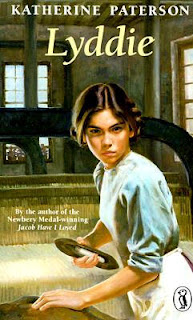
When I was about 9 years old, one of my favorite books was Lyddie by renowned childrens' author, Katherine Paterson. The story is about a young girl who flees to the Lowell mills to earn enough money to save her family's farm. Her path to success combines elements of the American dream with the cruelty of unchecked capitalism in a compelling and simple work of historical fiction. I am mildly embarrassed to admit that this novel provided my only background regarding Lowell for many years, mainly because I never had occasion to delve further into the subject.
Fortunately, this week's assigned public history reading was The Lowell Experiment: Public History in a Postindustrial City by Cathy Stanton. Needless to say, it has replaced Lyddie as my point of reference for Lowell. Stanton's analysis of public history as conducted at Lowell National Historical Park provides a multifaceted account of the background of the site, the people who preserve it, and the surrounding community. She places special emphasis on the presentation of socioeconomic issues which were the root of the shameful practices at Lowell and the reality for many people living in the surrounding community.
My favorite chapter of the book, entitled "Rituals of Reconnection" contains Stanton's research into the backgrounds and motives of the public historians at the Tsongas Center, a partner of Lowell Park. She discovers that, while these historians are largely white, educated, and middle-class, their achievement of that status is recent. Many reported a background of a lower socioeconomic status and credited their education for their class mobility. Stanton states, "For these people in 'the generation that broke the cycle,' Lowell NHP is more than just a place where they can learn more about the Industrial Revolution. It is, rather, a ritual space where they can locate themselves within changing socioeconomic realities and allay some of the anxieties involved in those changes" (168).
A similar perspective exists from the crowds of visitors who tour the park. While Lowell supposedly shows the guests "how it used to be," Stanton discovered that a large number of visitors readily connected the experiences of Lowell workers to their own lives. Union members relate to the labor movements, factory workers sympathize with the long hours, and everyone relates to the daily struggles and fears of the working class.
However, Stanton also notes that the efforts to preserve the Lowell mills as a historic site also create a dilemma by ignoring the fact that the surrounding community still endures many of the same hardships as turn-of-the-century laborers. Stanton's main critique is the rift that exists between the present day community and public historians at Lowell. She commends the efforts of public historians to bridge this gap by developing a new "Run of the Mill" exhibit which addresses modern issues surrounding Lowell and poses the tough questions about exactly how far the industry has come from its boom during the Industrial Revolution. Yet, Stanton sees this exhibit as a first step in a process that requires many more "social projects and alignments" in order to create an appropriate and productive relationship between historical sites and their public (237).
In the introduction to A Richer Heritage: Historic Preservation in the Twenty-first Century, Diane Lea also addresses this difficulty. She describes public history sites as embodying, "some of the nation's most profoundly defining ideals." Lea provides a brief history of the movement to preserve historical sites in the United States and how these movements have faced opposition in interactions with communities. Her essay emphasizes the theme and constant struggle of public vs. private ownership of history and how public historians have striven to balance this authority.
Everything seems to have gotten awfully complicated since the first time I curled up with my copy of Lyddie and learned about a place called Lowell. But the conversations of Lea and Stanton are valuable in their complexity. If there's one thing I've learned about public history this semester, it's that history and its meaning are fluid. Lowell is no longer a site with a set of facts and a simple, motion-picture-length story. It is a key component to a culture, a relationship, and an image. And those who have the responsibility of weaving these concepts together for public consumption are in for a good many finger pricks and long days bent over the loom.
And, no, I could not resist that corny textile metaphor. It was just too easy.

